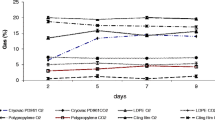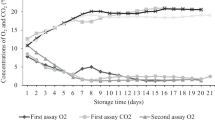Abstract
The impact of modified atmosphere packaging on the content of selected bioactive compounds and other quality attributes of Jalapeño peppers has not been well studied. In this study, Jalapeño peppers were packed in low-cost bags (composed of recycled-LDPE) that had been perforated at several levels (0-4 holes). Packages were stored at 7 °C for 6 weeks. Samples of unpacked peppers were stored at 23 and 7 °C and were used as control groups. The quality of the peppers and the gas composition inside of the packages were evaluated during storage. The best modified atmosphere was obtained with unperforated bags. Significant loss of weight and firmness were prevented by packaging. The loss of weight and firmness were 20.2–82.6 and 32–100 % in unpacked peppers. Low levels of fermentative metabolites accumulated in packed peppers in unperforated bags and in bags with 1 perforation. The tristimulus color and the bioactive compounds content (phenols, ascorbic acid, β-carotene, and capsaicinoids) remained unchanged in packed peppers. These quality attributes changed gradually in peppers that were stored at 23 °C. The tested bags represent a cost-effective alternative to preserve the quality of intact Jalapeño peppers.







Similar content being viewed by others
References
Alvarez-Parrilla E, de la Rosa LA, Amarowicz R, Shahidi F (2012) Protective effect of fresh and processed Jalapeño and Serrano peppers against food lipid and human LDL cholesterol oxidation. Food Chem 133:827–834
Arkus KAJ, Cahoon EB, Jez JM (2005) Mechanistic analysis of wheat chlorophyllase. Arch Biochem Biophys 438:146–155
Beaudry RM (1999) Effect of O2 and CO2 partial pressure on selected phenomena affecting fruit and vegetable quality. Postharvest Biol Technol 15:293–303
Chuah AM, Lee YC, Yamaguchi T, Takamura H, Yin LJ, Matoba T (2008) Effect of cooking on the antioxidant properties of coloured peppers. Food Chem 111:20–28
Cisneros-Pineda O, Torres-Tapia LW, Gutiérrez-Pacheco LC, Contreras-Martín F, González-Estrada T, Peraza-Sánchez SR (2007) Capsaicinoids quantification in chili peppers cultivated in the state of Yucatan, Mexico. Food Chem 104:1755–1760
Deli J, Molnár P, Matus Z, Tóth G (2001) Carotenoid composition in the fruits of red paprika (Capsicum annuum var. lycopersiciforme rubrum) during ripening; biosynthesis of carotenoids in red paprika. J Agric Food Chem 49:1517–1523
Gómez-Ladrón de Guevara R, Pardo-González JE (1996) Evolution of color during the ripening of selected varieties of paprika pepper (Capsicum annuum L.). J Agric Food Chem 44:2049–2052
González M, Centurión A, Sauri E, Latournerie L (2005) Influence of refrigerated storage on the quality and shelf life of ‘Habanero’ chili peppers (Capsicum chinense Jacq.). Acta Hortic 682:1297–1302
González-Aguilar GA, Tiznado M (1993) Postharvest physiology of Bell peppers stored in low density polyethylene bags. Lebensm Wiss Technol 26:450–455
González-Aguilar GA, Ayala-Zavala JF, Ruiz-Cruz S, Acedo-Félix E, Díaz-Cinco ME (2004) Effect of temperature and modified atmosphere packaging on overall quality of fresh-cut bell peppers. Lebensm Wiss Technol 37:817–826
Hornero-Méndez D, Gómez-Ladrón de Guevara R, Mínguez-Mosquera MI (2000) Carotenoid biosynthesis changes in five red peppers (Capsicum annuum L.) cultivars during ripening. Cultivar selection for breeding. J Agric Food Chem 48:3857–3864
Howard LR, Hernández-Brenes C (1998) Antioxidant content and market quality of jalapeno pepper rings as affected by minimal processing and modified atmosphere packaging. J Food Qual 21:317–327
Howard LR, Smith RT, Wagner AB, Villalon B, Burn EE (1994) Provitamin A and ascorbic acid content of fresh pepper cultivars (Capsicumannuum) and processed jalapenos. J Food Sci 59:362–365
Howard LR, Talcott ST, Brenes CH, Villalon B (2000) Changes in phytochemical and antioxidant activity of selected pepper cultivars (Capsicum species) as influenced by maturity. J Agric Food Chem 48:1713–1720
Imahori Y, Kota M, Ueda Y, Ishimaru M, Cachin K (2002) Regulation of ethanolic fermentation in bell pepper fruit under low oxygen stress. Postharvest Biol Technol 25:159–167
Johnson CD, Decoteau DR (1996) Nitrogen and potassium fertility affects Jalapeno pepper plant growth, pod yield, and pungency. HortSci 31:1119–1123
Kissinger M, Tuvia-Alkalai S, Shalom Y, Fallik E, Elkind Y, Jenks MA, Goodwin MS (2005) Characterization of physiological and biochemical factors associated with postharvest water loss in ripe pepper fruit during storage. J Am Soc Hortic Sci 130:735–741
Koide S, Shi J (2007) Microbial and quality evaluation of green peppers stored in biodegradable film packaging. Food Control 18:1121–1125
Kosson R (2003) Chlorophyll fluorescence and chilling injury of green pepper as affected by storage conditions. Acta Hortic 628:379–385
Krajewska AM, Powers JJ (1987) Gas chromatography of methyl derivatives of naturally occurring capsaicinoids. J Chromatogr A 409:223–233
Lee Y, Howard LR, Villalón B (1995) Flavonoids and antioxidant activity of fresh pepper (Capsicum annuum) cultivars. J Food Sci 60:473–476
Lownds NK, Banaras M, Bosland PW (1994) Postharvest water loss and storage quality of nine pepper (Capsicum) cultivars. HortSci 29:191–193
Luo Y, Mikitzelf LJ (1996) Extension of postharvest life of Bell peppers with low oxygen. J Sci Food Agric 70:115–119
Manolopoulou H, Xanthopoulos G, Douros N, Lambrinos G (2010) Modified atmosphere packaging storage of green bell peppers: quality criteria. Biosyst Eng 106:535–543
Matsufuji H, Ishikawa K, Nunomura O, Chino M, Takeda M (2007) Anti-oxidant content of different coloured sweet peppers, white, green, yellow, orange and red (Capsicum annuum L.). Int J Food Sci Techol 42:1482–1488
Meir S, Rosenberger I, Aharon Z, Grinberg S, Fallik E (1995) Improvement of the postharvest keeping quality and colour development of bell pepper (cv. ‘Maor’) by packaging with polyethylene bags at a reduced temperature. Postharvest Biol Technol 5:303–309
Mejia LA, Hudson E, González de Mejia E, Vazquez F (1988) Carotenoid content and vitamin A activity of some common cultivars of Mexican peppers (Capsicum annuum) as determined by HPLC. J Food Sci 53:1448–1451
Niu G, Rodriguez DS, Call E, Bosland PW, Ulery A, Acosta E (2010) Responses of eight chile peppers to saline water irrigation. Sci Hortic 126:215–222
Ornelas-Paz JJ, Cira-Chávez LA, Gardea-Béjar AA, Guevara-Arauza JC, Sepúlveda DR, Reyes-Hernández J, Ruiz-Cruz S (2013) Effect of heat treatment on the content of some bioactive compounds and free radical-scavenging activity in pungent and non-pungent peppers. Food Res Int 50:519–525
Ornelas-Paz JJ, Martínez-Burrola JM, Ruiz-Cruz S, Santana-Rodríguez V, Ibarra-Junquera V, Olivas GI, Pérez-Martínez JD (2010) Effect of cooking on the capsaicinoids and phenolics contents of Mexican peppers. Food Chem 119:1619–1625
Ornelas-Paz JJ, Zamudio-Flores PB, Torres-Cisneros CG, Holguín-Soto R, Ramos-Aguilar OP, Ruiz-Cruz S, Guevara-Arauza JC, González-Aguilar GA, Santana-Rodríguez V (2012) The barrier properties and potential use of recycled-LDPE films as a packaging material to preserve the quality of Jalapeño peppers by modified atmospheres. Sci Hortic 135:210–218
Pankotai MG, Komsa I, Fustos Z (2007) Quality changes of paprika types during the storage in Hungary. Acta Hortic 747:179–184
Ruiz-Cruz S, Alvarez-Parrilla E, de la Rosa LA, Martínez-González AI, Ornelas-Paz JJ, Mendoza-Wilson AM, González-Aguilar GA (2010) Effect of different sanitizers on microbial, sensory and nutritional quality of fresh-cut jalapeño peppers. Am J Agric Biol Sci 5:331–341
Saltveit ME (2003) Is it possible to find an optimal controlled atmosphere? Postharvest Biol Technol 27:3–13
Srinivasan K (2005) Spices as influencers of body metabolism: an overview of three decades of research. Food Res Int 38:77–86
Traber MG, Stevens JF (2011) Vitamins C and E: Beneficial effects from a mechanistic perspective. Free Radic Biol Med 51:1000–1013
Wall MM, Waddell CA, Bosland PW (2001) Variation in β-carotene and total carotenoid content in fruits of Capsicum. HortSci 36:746–749
Yahia EM, Ornelas-Paz JJ (2010) Chemistry, stability and biological actions of carotenoids. In: De la Rosa L, Alvarez-Parrilla E, González-Aguilar GA (eds) Fruit and vegetable phytochemicals: chemistry, nutritional value and stability. Blackwell Publishing, USA, pp 177–222
Yahia EM, Ornelas-Paz JJ, González-Aguilar GA (2011) Nutritional and health promoting properties of tropical and subtropical fruits. In: Yahia EM (ed) Postharvest biology and technology of tropical and sub-tropical fruits. Vol. 1: Fundamental Issues. Woodhead Publishing, Cambridge, pp 21–78
Acknowledgments
This research was fully funded by the Fondo Sectorial de Investigación para la Educación (Investigación Básica SEP-CONACYT; Project Clave: 103391). The authors would like to thank Ana Lourdes Ramos and Emilio Ochoa-Reyes for their technical assistance.
Author information
Authors and Affiliations
Corresponding author
Rights and permissions
About this article
Cite this article
de Jesús Ornelas-Paz, J., Castañeda-Jiménez, A.C., Estrada-Alvarado, M.I. et al. Effect of the perforation level of recycled-LDPE bags on the modification of the atmosphere development, bioactive compounds content, and other qualities of Jalapeño peppers during storage. J Food Sci Technol 52, 6415–6424 (2015). https://doi.org/10.1007/s13197-015-1749-8
Revised:
Accepted:
Published:
Issue Date:
DOI: https://doi.org/10.1007/s13197-015-1749-8




